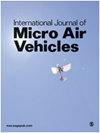仿生风场估计——第1部分:通过表面压力分布测量攻角
IF 1.6
4区 工程技术
Q2 ENGINEERING, AEROSPACE
引用次数: 10
摘要
小型无人机飞行的主要挑战之一是在低层大气边界层飞行时与湍流环境的非定常相互作用。根据自然的启发,我们提出了一种基于机翼压力测量的迎角估计新系统。这种设备可以用于飞行期间攻角的实时估计,或者甚至可以使用附加设备进一步构建风速矢量。这些信息可以在飞机的控制和稳定中找到目的,这是由于机翼所看到的不平等,甚至是对于依赖主动控制来提取能量的各种飞行策略。为此,飞翼飞机已被用于估计局部迎角,共有四个翼展位置。通过机翼上的压差测量来估计飞行攻角,并与带风向标的磁传感器进行了比较。结果表明,与连接在专门设计的气动臂上的风向标给出的值相比,压力端口可以更可靠地估计攻角。四个翼展位置局部攻角的差异证实了低空飞行中湍流的空间变化。此外,用Kaimal谱描述的风分量的能量耗散理论规律与估计值吻合良好。本文章由计算机程序翻译,如有差异,请以英文原文为准。
Bioinspired wind field estimation—part 1: Angle of attack measurements through surface pressure distribution
One of the major challenges of Mini-Unmanned Aerial Vehicle flight is the unsteady interaction with turbulent environment while flying in lower levels of atmospheric boundary layer. Following inspiration from nature we expose a new system for angle of attack estimation based on pressure measurements on the wing. Such an equipment can be used for real-time estimation of the angle of attack during flight or even further building of wind velocity vector with additional equipment. Those information can find purpose in control and stabilization of the aircraft due to inequalities seen by the wing or even for various soaring strategies that rely on active control for energy extraction. In that purpose, flying wing aircraft has been used with totally four span-wise locations for local angle of attack estimation. In-flight angle of attack estimation from differential pressure measurements on the wing has been compared with magnetic sensor with wind vane. The results have shown that pressure ports give more reliable estimation of angle of attack when compared to values given by wind vane attached to a specially designed air-boom. Difference in local angle of attack at four span-wise locations has confirmed spatial variation of turbulence in low altitude flight. Moreover, theoretical law of energy dissipation for wind components described by Kaimal spectrum has shown acceptable match with estimated ones.
求助全文
通过发布文献求助,成功后即可免费获取论文全文。
去求助
来源期刊

International Journal of Micro Air Vehicles
ENGINEERING, AEROSPACE-
CiteScore
3.00
自引率
7.10%
发文量
13
审稿时长
>12 weeks
期刊介绍:
The role of the International Journal of Micro Air Vehicles is to provide the scientific and engineering community with a peer-reviewed open access journal dedicated to publishing high-quality technical articles summarizing both fundamental and applied research in the area of micro air vehicles.
 求助内容:
求助内容: 应助结果提醒方式:
应助结果提醒方式:


